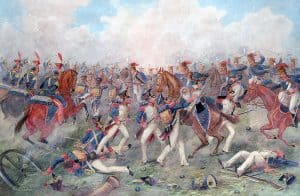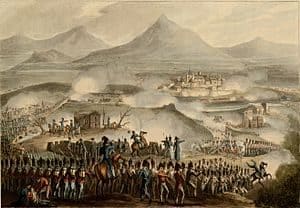The Peninsular War
Finally, in December 1808 the 4th sailed to Portugal to join Wellesley’s Army which was trying to push the French out of Portugal by bringing them to battle in Spain. They achieved this at Talavera in July 1809.
Talavera 28 July 1809
The 4th Queen’s Own Dragoons were present at the battle of Talavera, but the action was in effect a slogging match between the infantry forces.
Fane’s Brigade, which contained the 4th, were ordered to charge a large body of French infantry immediately following Anson’s Brigade; the latter charged headlong into a well-hidden ditch which completely destroyed their momentum, and on seeing this Wellington ordered Fane’s to return to the line.
There was no rout at Talavera, the victor being decided by a tally of casualties and the withdrawal of the French forces that night. Although they saw no direct action the 4th did suffer some casualties.
Two years of defence consolidated Britain’s last remaining Army until 1811 at Albuhera when although the Beresford lost half the English number in the battle, the French lost double that.
Albuhera 16 May 1811
The 4th Queen’s Own Dragoons played two distinct roles in this important battle at the turning point of the Peninsular Campaign. In the early stages, the left wing of the 4th was ordered to hold the bridge over the River Albuhera and with the 13th Light Dragoons, did so throughout the battle, enduring five hours of heavy fire from artillery and musketry.
The two squadrons of the right wing later charged and dispersed two regiments of Polish Lancers and Hussars that had surrounded and cut off a brigade of allied infantry. They then advanced with infantry into the left flank of the French line, who eventually broke and fled.
The whole of the allied cavalry then gave chase to the retreating French army. The latter sent back a delaying force of ten regiments of cavalry. The clash took place in a spectacular fashion on 25 May at Usage when the 4th and the 3rd Dragoon Guards charged and destroyed three regiments of French cavalry caught on a bridge.
The masterstroke was at Salamanca in July 1812.
Salamanca 22 July 1812
Both The 3rd King’s Own Regiment of Dragoons and The 4th Queen’s Own Regiment of Dragoons fought with distinction at Salamanca.
They were two of the three regiments that made up Le Marchant’s famous heavy Brigade that took part in a murderous charge described by Wellington with praise, “I never saw anything so beautiful in all my life”.
After the rout, The 4th Dragoons captured some of Joseph Bonaparte’s silver from the baggage train which was melted down to provide cutlery and the Salamanca Donkey in the Officers’ Mess.
The following year The 4th Dragoons were again in action, this time at Vittoria.
Vittoria 21 June 1813

The Battle of Vittoria 1813
The 3rd King’s Own Regiment of Dragoons and The 4th Queen’s Own Regiment of Dragoons fought together again as part of Ponsonby’s Heavy Brigade in this battle where the French decided to make a stand against Wellington’s armies.
Unfortunately, they were not called upon but were commended for maintaining their position and holding steady in the centre of the line.
After the French had broken, they were ordered to pursue; in so doing they had to ride through Vittoria itself where a lot of the allied army were busying themselves looting the baggage of the French.
At one stage the Brigade rode along a track to the side of which lay a large mound of silver dollars – not one man stopped to help himself, and a Sergeant-Major was left behind to gather up the money which was then equally divided amongst the whole Brigade.
After this battle, the French were finally pushed out of Spain and into France where the final battle in the Peninsular War was fought and won in 1814 at Toulouse.
Toulouse 10 April 1814

The Battle of Toulouse 1814
The 3rd King’s Own Regiment of Dragoons and The 4th Queen’s Own Regiment of Dragoons fought together again as part of Ponsonby’s Heavy Brigade in this final battle of the Peninsular War.
They supported the Spanish infantry in the centre of the line and enabled them to reform after their initial assault had been repulsed, and then saved the Portuguese guns from being captured.
Only after the battle was won did the Allies learn that Napoleon had abdicated five days earlier.
From Toulouse, the 4th marched the 700 miles to Boulogne and embarked for England.
1818 saw another clarification of the titles they had become The 4th or Queen’s Own Regiment of Light Dragoons.
Campaign Medal
 The Military General Service Medal 1793 – 1814 was authorised by a General Order dated 1st June 1847 and issued in 1848. This was a campaign medal for the issue to officers and men of the British Army, and sometimes it was referred to as the Peninsular Medal. It covers military actions from 1793-1814; a period encompassing the French Revolutionary Wars, the Napoleonic Wars, and the Anglo-American War of 1812.
The Military General Service Medal 1793 – 1814 was authorised by a General Order dated 1st June 1847 and issued in 1848. This was a campaign medal for the issue to officers and men of the British Army, and sometimes it was referred to as the Peninsular Medal. It covers military actions from 1793-1814; a period encompassing the French Revolutionary Wars, the Napoleonic Wars, and the Anglo-American War of 1812.
Each battle or action covered by the medal was represented by a clasp on the ribbon, with twenty-nine bars being awarded, fifteen being the most to any one recipient. The bars are fixed in multiples of three where applicable.
The bars mainly commemorate actions of the Peninsular War but also include various campaigns across the globe such as the West Indies, Egypt, and Java, the United States of America.
It is to be noted that the medal was only awarded to surviving claimants; one had both to have survived until 1847 and then to actively apply for it. A combination of factors, from general illiteracy to limited publicity for the new medal meant that many did not. There are substantially fewer medals issued compared with the number of men who served during this period.
The medal was awarded only to surviving claimants; next of kin could not apply for a medal on behalf of a deceased relative. However, the medal was awarded to the next of kin of those claimants who had died between the date of their application and the date of presentation.
Twenty Nine Bars were Issued;
Egypt, Maida, Roleia, Vimiera, Sahagun, Benevente, Sahagun and Benevente, Corunna, Martinique, Talavera, Guadaloupe, Busaco, Barrosa, Fuentes D’Onor, Albuhera, Java, Ciudad Rodrigo, Badajoz, Salamanca, Fort Detroit, Chateauguay, Chrystler’s Farm, Vittoria, Pyrenees, St Sebastian, Nivelle, Nive, Orthes, Toulouse.

